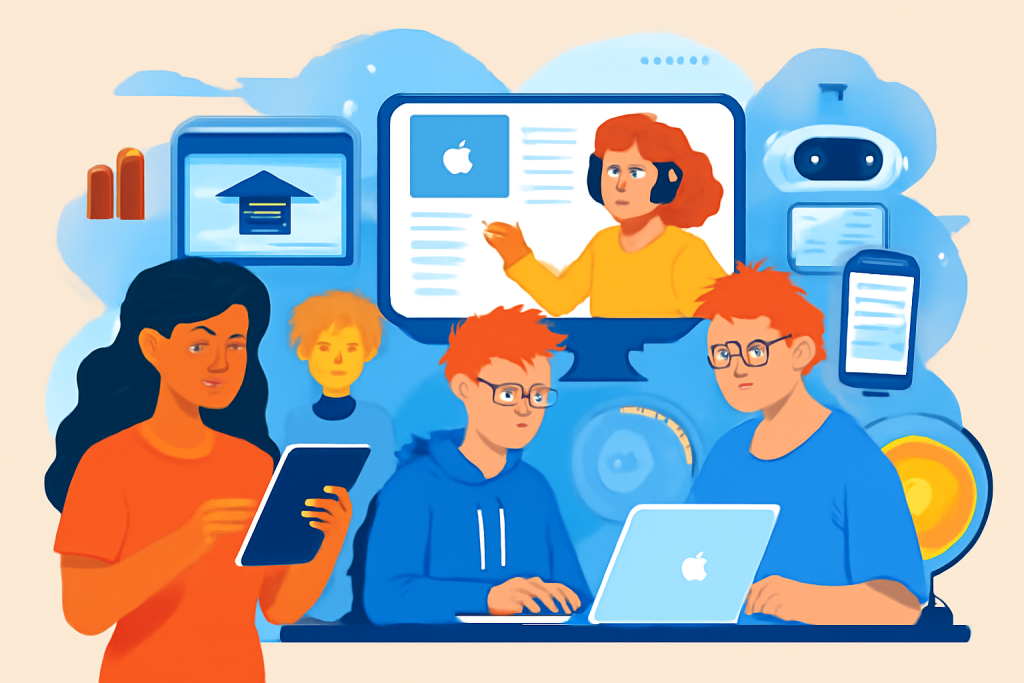The world of education is undergoing a monumental shift, thanks to the surge in digital tools that are transforming the way we learn. From personalized learning experiences to the rise of virtual classrooms, technology is playing a pivotal role in reshaping how students of all ages engage with educational content. As digital tools are changing the way we learn these digital platforms continue to evolve, the classroom experience is becoming more dynamic, interactive, and accessible than ever before.

Education is no longer confined to the traditional classroom. Digital tools are changing the way we learn, they are breaking down barriers and making learning more accessible to students across the globe. Whether it’s through interactive apps, online courses, or virtual reality experiences, technology is reshaping how knowledge is delivered and consumed. In this article, we’ll explore the key ways digital tools are revolutionizing education today.
The Rise of Online Learning Platforms
One of the most prominent changes in education today is the proliferation of online learning platforms. Websites like Coursera, Khan Academy, and edX have made it easier than ever for students to access high-quality education from the comfort of their homes. These digital tools are changing the way we learn by providing a wide variety of courses, ranging from basic skills to advanced degrees, allowing learners to pursue their academic interests at their own pace.
Key Benefits of Online Learning:
- Flexibility: Students can learn whenever and wherever they choose, making education more accessible to those with busy schedules.
- Variety: With thousands of courses available, learners can choose subjects that match their passions or career goals.
- Affordability: Many online courses are free or available at a fraction of the cost of traditional education, making learning more affordable than ever before.
The global reach of these platforms has also leveled the playing field for students in remote areas, providing them with access to the same quality of education as those in more developed regions. The democratization of education through online platforms is one of the most significant ways digital tools are changing the way we learn.
Virtual and Augmented Reality: Creating Immersive Learning Experiences
Another game-changing development in education is the use of virtual reality (VR) and augmented reality (AR) in the classroom. These digital tools are changing the way we learn and create immersive learning environments that make education more engaging and interactive. For example, students studying history can take virtual field trips to ancient civilizations, while medical students can practice surgery in a risk-free virtual environment.
Benefits of VR and AR in Education:
- Engagement: VR and AR create highly interactive experiences that help students retain information better.
- Practical Experience: Students can practice real-world skills in a virtual setting, making learning more hands-on and applicable.
- Accessibility: For students with disabilities, VR and AR can offer customized learning experiences tailored to their needs.
As VR and AR technologies continue to improve, they are likely to become a standard part of education, providing students with a deeper, more meaningful learning experience.
Artificial Intelligence: Personalized Learning at Scale
Artificial intelligence (AI) is another technology that is transforming education. AI-powered tools can analyze data about a student’s learning habits and personalize their education accordingly. For example, AI can recommend specific resources or exercises based on a student’s strengths and weaknesses, providing a tailored learning experience that adjusts as the student progresses.
Key Advantages of AI in Education:
- Personalization: AI allows for a more individualized approach to learning, helping students learn at their own pace and in ways that suit their learning style.
- Instant Feedback: AI-powered systems can provide immediate feedback, helping students identify areas where they need improvement.
- Efficiency: Teachers can use AI to automate administrative tasks, such as grading, allowing them to focus more on teaching.
AI is making it possible to scale personalized education, allowing for more effective teaching methods without overwhelming teachers. With AI’s ability to adapt to each learner’s needs, students can enjoy a more efficient and tailored learning process.
Collaborative Tools: Enhancing Interaction and Communication
Collaboration is a key aspect of the learning process, and digital tools are making it easier for students to work together, even when they are miles apart. Platforms like Google Classroom, Microsoft Teams, and Zoom allow students and teachers to interact in real-time, exchange ideas, and collaborate on projects without being in the same room.
Benefits of Collaborative Digital Tools:
- Real-Time Communication: Students can ask questions, engage in discussions, and receive feedback from teachers and peers instantly.
- Group Work: Students can collaborate on assignments, share resources, and contribute to projects seamlessly, regardless of location.
- Global Networking: Students can connect with peers around the world, enhancing their learning experience and broadening their perspectives.
These collaborative tools have been particularly important in the wake of the COVID-19 pandemic, which forced educational institutions to shift to remote learning. As a result, students and teachers have become more comfortable with digital communication, making it a permanent part of education moving forward.
Gamification: Making Learning Fun and Engaging
Gamification is another digital tool that has gained traction in education. By incorporating game-like elements, such as points, levels, and badges, educators can make learning more engaging and fun. Platforms like Kahoot! and Duolingo have successfully used gamification to enhance student participation and motivation.
Benefits of Gamification in Education:
- Increased Motivation: Students are more likely to stay engaged when learning feels like a game.
- Instant Rewards: Gamification provides students with immediate feedback, motivating them to keep progressing.
- Skill Building: Games can help students develop important skills, such as problem-solving, critical thinking, and teamwork.
Gamification has proven to be an effective way to keep students motivated, particularly for younger learners. As it becomes more integrated into educational platforms, gamification is likely to become a standard practice in classrooms worldwide.
Conclusion: The Future of Learning Is Digital
Digital tools are revolutionizing education by making it more flexible, personalized, and engaging. Online learning platforms, virtual and augmented reality, artificial intelligence, collaborative tools, and gamification are just a few examples of how technology is changing the way we learn. As these tools continue to evolve, the possibilities for education are limitless.
The future of learning is digital, and it’s clear that technology will continue to play a vital role in shaping the education of tomorrow. Whether you’re a student looking to learn new skills or an educator seeking to enhance your teaching methods, embracing these digital tools is the key to success in this new era of education.
References:
- Christensen, C. M., Horn, M. B., & Staker, H. (2013). Disrupting Class: How Disruptive Innovation Will Change the Way the World Learns. McGraw-Hill.
- Weller, M. (2020). The Digital University: A Dialogue and Manifesto. Routledge.
- Popenici, S. A. D., & Kerr, S. (2017). “Exploring the impact of artificial intelligence on teaching and learning in higher education.” Higher Education Research & Development, 36(1), 1-14. Available at: https://doi.org/10.1080/07294360.2017.1370731









